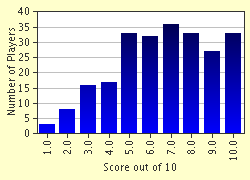Quiz Answer Key and Fun Facts
1. A set of six-foot statues of the Queen's Beasts was created for this event in 1953. Which?
2. Griffins have the head and talons of an eagle and the body, hind paws and tail of a lion. In heraldry, this combination signifies wisdom and strength, with "wisdom leading". The Griffin among the Queen's Beasts is referred to as "The Griffin of ______", who ruled England from 1327-1377 and fathered the Black Prince.
3. The Queen's Beasts include two lions: The Lion of England, first used by Henry II and possibly earlier, and certainly by Richard I (Coeur de Lion - makes sense) and the white Lion of Mortimer. In British royal heraldry, what are the two most common poses for lions?
4. In 1998, the Queen's Beasts were the subject of a series of postage stamps issued by the British Royal Mail. One of the stamps featured a silver falcon, symbol of this dynasty whose descendants founded the houses of York and Lancaster, the two opposing sides in the Wars of the Roses. Which dynasty was it?
5. The Black Bull was the symbol of the House of Clarence, whose members were allies of the royal House of York. In the language of heraldry, how is "Black Bull" to be expressed?
6. One of the oddest of the Queen's Beasts is the Yale of Beaufort. Which of the following descriptions fits the Yale?
7. Both Henry VII and his son Henry VIII used a dragon and this canine (the symbol of the House of Richmond) as supporters of their coats of arms. What is this regal dog, much favored by royalty?
8. This creature has long been the symbol of Wales. In 1485, the Welsh Henry Tudor fought under its banner at Bosworth Field, defeating Richard III and becoming King Henry VII of England. It has a long history in the myths and legends of many countries worldwide.
9. The Unicorn of Scotland became part of the Royal Arms with the accession of James I of England (James VI of Scotland). The Unicorn had been part of the Scottish Royal Arms for about a century. Although Scotland is part of the United Kingdom, what is different about the arms the monarch uses while actually in Scotland?
10. Chronologically speaking, the Horse of Hanover is the newest of the Queen's Beasts. The first Hanoverian monarch was George I, who reigned from 1714-1727. Is the present monarch of Great Britain a direct descendant of George I?
Source: Author
LilahDeDah
This quiz was reviewed by FunTrivia editor
bloomsby before going online.
Any errors found in FunTrivia content are routinely corrected through our feedback system.

